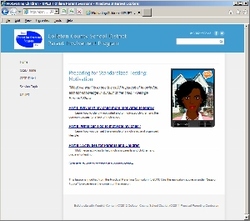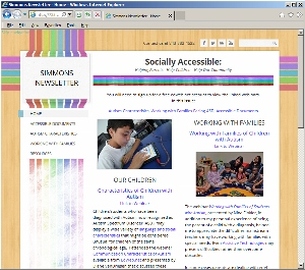AECT Standard 2: DEVELOPMENTCandidates demonstrate the knowledge, skills, and dispositions to develop instructional materials and experiences using print, audiovisual, computer-based, and integrated technologies.
Artifact 1 Motivating Children Online Session: http://parents.ccsdtitle1.org/motivating-children/
Indicators2.0.1, 2.0.5, 2.0.6, 2.0.7, 2.1.4, 2.2.1, 2.2.2, 2.2.3, 2.3.1, 2.3.2, 2.4.2, 2.4.5, 5.1.1, 5.3.1: As demonstrated in the artifact, the lesson uses appropriate design principles, techniques, and technologies for a distance education format (online course with audio, video, print components). The process of re-designing the lesson required selection and use of appropriate media, design principles, instructional techniques, and demonstration of an understanding of media and visual literacy skills. The lesson contains formative and summative assessments as well as links for learners to assess the quality and effectiveness of instruction using a SurveyMonkey Survey. Based on assessments of the original lesson and acquired competencies, I developed multimedia components for the lesson in a distance-learning format. Additionally I created new supplementary materials and games in print and multimedia formats that were not a part of the original lesson. Context:For EDET 709 in the Spring of 2012, I redesigned the distance education lesson on motivating children I originally developed as a project for EDET 703 earlier that semester using different technological tools and fewer multimedia components. The redesign project followed the ADDIE model of instructional design and focused on the design and development phases in order to develop and implement the redesigned lesson/site.Conditions:This was an individual project that required application of research-based strategies and techniques for evaluation of the original project and for design changes to improve the quality of the product. Use of the content required getting permission from the content creator and appropriate references and acknowledgements are given.Scope:The product is available to parents in Colleton County via the artifact link. This lesson is the structural basis for future lessons.Role:I am the sole designer of the original and redesigned websites, citations/attributions for content and media are included on the project pages.Artifact 2
Accessible Online Newsletter: http://735final.shelbyesimmons.me/
Indicators2.1.4, 2.4.2, 2.4.5: The artifact demonstrates district policies for professional development, webpages, and communication and is designed to be an enhanced newsletter – a common format for print or web based professional development content/support. The site features appropriately linked pages. Context:The Accessible Online Newsletter is the final exam for EDET 735 (Spring 2013). This artifact demonstrates a web version of a text-based form of professional development for educators within our school district – a newsletter. The theme supports my design project for the class and is a resource for that project showing how text based instruction can support multimedia instruction and accessibility issues as the Newsletter is designed adhere to accessibility guidelines. The content establishes some guidelines and policies for working with children who are diagnosed with autism and their parents by applying UDL and using or providing assistive technologies.Conditions:The site design followed the ADDIE instructional design process and is in the implementation/evaluation phase(s). The format of an accessible online newsletter was a requirement of the project. The site was built with Weebly and I edited the CSS and HTML templates to improve accessibility.Scope:This Newsletter has been submitted for the course, however it is a component of my project, and as such will become a part of the online offerings of Professional Development and Parental Involvement in my school district.Role:I designed the Newsletter/artifact as a solo project using the ADDIE design model, selecting images and linking resources in harmony with AECT Standard 2 and school district policy.Artifact Navigation:Design - Development - Utilization - Management - EvaluationDownload Required Programs - Back to top |
Performance Indicators2.0.1 Select appropriate media to produce effective learning environments using technology resources.
2.0.3 Apply instructional design principles to select appropriate technological tools for the development of instructional and professional products. 2.0.4 Apply appropriate learning and psychological theories to the selection of appropriate technological tools and to the development of instructional and professional products. 2.0.5 Apply appropriate evaluation strategies and techniques for assessing effectiveness of instructional and professional products. 2.0.6 Use the results of evaluation methods and techniques to revise and update instructional and professional products. 2.0.7 Contribute to a professional portfolio by developing and selecting a variety of productions for inclusion in the portfolio. 2.1 Print Technologies 2.1.1 Develop instructional and professional products using a variety of technological tools to produce text for communicating information. 2.1.2 Produce print communications (e.g., flyers, posters, brochures, newsletters) combining words and images/graphics using desktop publishing software. 2.1.3 Use presentation application software to produce presentations and supplementary materials for instructional and professional purposes. 2.1.4 Produce instructional and professional products using various aspects of integrated application programs. 2.2 Audiovisual Technologies 2.2.1 Apply principles of visual and media literacy for the development and production of instructional and professional materials and products. 2.2.2 Apply development techniques such as storyboarding and or scriptwriting to plan for the development of audio/video technologies. 2.2.3 Use appropriate video equipment (e.g., camcorders, video editing) to prepare effective instructional and professional products. 2.3 Computer-Based Technologies 2.3.1 Design and produce audio/video instructional materials which use computer-based technologies. 2.3.2 Design, produce, and use digital information with computer-based technologies. 2.4 Integrated Technologies 2.4.1 Use authoring tools to create effective hypermedia/multimedia instructional materials or products. 2.4.2 Develop and prepare instructional materials and products for various distance education delivery technologies. 2.4.3 Combine electronic and non-electronic media to produce instructional materials, presentations, and products. 2.4.4 Use telecommunications tools such as electronic mail and browsing tools for the World Wide Web to develop instructional and professional products. 2.4.5 Develop effective Web pages with appropriate links using various technological tools (e.g., print technologies, imaging technologies, and video). |

